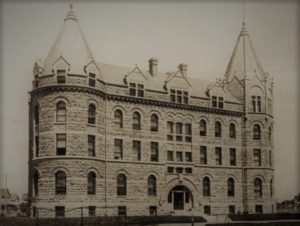In his book, The Icelandic People in Manitoba Wilhelm Kristjanson writes on Rev. Rognvaldur Petursson.

Wesley College, Winnipeg, Manitoba. Photo Manitoba Archives
“At the turn of the century the Unitarian congregation in Winnipeg was small in number and not firmly established. With the appointment of Reverend Rognvaldur Petursson as minister in August 1903, the congregation entered a period of growth and activity. Reverend R. Petersson was born in Iceland in 1877. The family emigrated to America in 1883, settling at Hallson in the Sandhills district in Dakota. At Hallson the Peturssons were neighbors to a number of men later prominent, evern Eminent, in public life, business, letters, and science and exploration, Including Stephan G. Stephansson (who moved to Alberta in 1889) and Vilhjalmur Stefansson. The intellectual climate was stimulating. ”
Education – Early work
“There was at this time close association between the Icelandic people in Dakota and Manitoba and Petursson attended Wesley College in Winnipeg in the years 1896-1898. He then proceeded to the theological seminary at Meadville in Pennsylvania, where he received his B.D. degree in 1902. From Meadville he proceeded to Harvard University on a Perkins scholarship, for further study in theology and Ancient Norse and Germanic studies. At Harvard he was the contemporary of two brilliant students, Vilhjalmur Stefansson and Thorvaldur Thorvaldson. The three combined their resources in “living on a shoestring”. As student preacher Petursson had been considered too pholosophical in his discourses, but he quickly outgrew this tendency. His sermons were elevated in thought, imaginative, models of structure and form, and polished in style. Human sympathy was revealed especially in his funeral orations. He found a basic unity in all religions, despite much diversity and many contradictions. All people were travelling to the promised land. The essence of religion was for him a search to reconcile belief in God and awareness of the material world. A basic theme was the Fatherhood of God and the Brotherhood of Man. The third of the five points of Unitarianism set forth in the catechism compiled by Petursson and Reverend Gudmundur Arnason was the leadership of Jesus. Following a period in the history of the congregation when some of its member concentrated on destructive criticism of orthodox religions, Petursson pointed to the constructive task ahead of building a fairer temple on the ruins of the old.”
Growth in Winnipeg

The Unitarian Church in Winnipeg Photo Unitarian Universalist Association
“In the six years following Petursson´s appointment a new and substantial church building was erected, group activities were organized, and a liberal religion periodical commenced publication. The membership of the congregation doubled. Available records show that, including members who had passed through, eighty-five persons had joined by 1903 and some two hundred by 1909. In the first years of the new century many young people, including university students, joined the congregation. The new minister himself was young and boyant of spirit and he had personal charm. One of the university students mentioned observed many years later that this period was spring-time in the life of the congregation. The move from this original church building was made in 1904, the old location no longer suitable because of a general movement of the Icelandic people to the western and southern parts of the city. The new building, which was located on the corner of Sargent Avenue and Nena Street, was dedicated in 1905. The dedication sermon was delivered by Reverend F. S. Southworth, President of the Meadville Theological Seminary. The building was a one and a half storey brick building 56 by 36 feet and main auditorium had a seating capacity of some three hundred. The cost was about 13.000 dollars, 6,000 of which was a debt on the completion of the work. The Unitarian Association in Boston again proved helpful and advanced a loan. The new church was modelled on the Unitarian church at Baltimore, where in 1819 William Ellery Channing delivered a memorable serman. The design, with its low-pitched roof and pillared porch, resembled that of Athenian temple. The stained glass windows were designed by the architect of the building, Fridrik (Fred) Swanson.”
Cultural Society – Monthly publication
“A cultural society, the Menningarfelag, was organixed in connection with the church in 1906. The chief promoter and first president was Skapti Brynjolfsson, sometime president of the Menningarfelag in North Dakota, and the purpose was that of the earlier organization, the fostering of knowledge and the development of a broader outlook on life. Membership in the society was open to both sexes and all ages, regardless of church affiliation. Addresses or lectures followed by a discussion were a prominent feature of the programmes. Guest speakers over a period of years included nine ministers, four medical doctors, four journalists or newspapermen, four university students, four business men, five artisans, two labor leaders, and one lawyer. These addresses were in Icelandic, with the exception of four English Canadian guest speakers. Meetings were open to the public and a précis of the lectures was usually published in the local Icelandic language papers. The society flourished until the outbreak of the First World War and had a far-reaching indluence in bringing together people of diverse views. Mutual acquaintance led to better understanding. The society maintained a written paper Ar (Ár) usually some eight foolscap pages of original articles, stories, and poems. The editor was Eggert Arnason. Another feature of lively social gatherings was the performance of the Danish folk dance “The Weaving of the Frieze”. A monthly publication, Heimir, was founded in 1904. The chief promoters were Reverend R. Petursson and Gisli Jonsson, printer and publisher and man of letters.”
